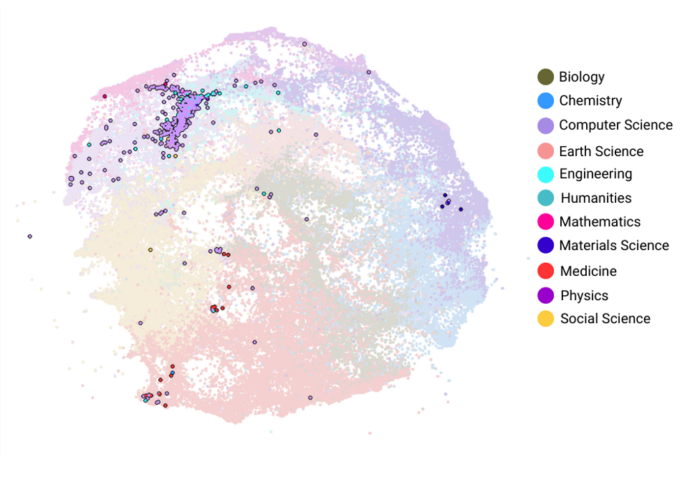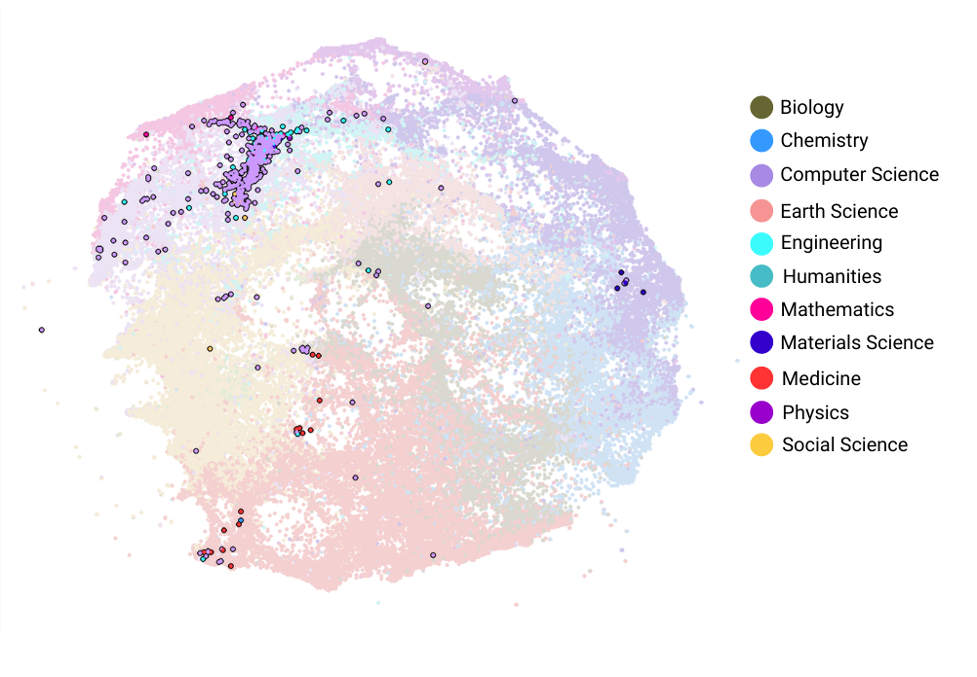We round out this snapshot series investigating artificial intelligence (AI)-related topics in scholarly literature with a look at robotics research. Specifically, we explore the 477 research clusters (as of July 29, 2021) with over 25 percent of their papers falling into the robotics research category and at least 25 percent of papers classified as AI-related, as described in Defining Computer Vision, Natural Language Processing, and Robotics Research Clusters.1
Additionally, we will provide an overview of the most concentrated robotics RC compared to the least concentrated robotics RC.
Generally speaking, robotics has been a mainstream field of technological research and development for a longer period of time than AI. Some robotics technologies may not completely fall under the conventional domain of AI (think “robotic arms” that are manually human-operated). One example of robotics-AI technologies would be autonomous vehicles that use sensors to process external information (e.g. vibrations of what is nearby, sounds, light) and then operate accordingly. Another example is the iRobot Roomba, and other home cleaning robots. Robots, both AI-related and otherwise, are critical technologies that affect countries’ productive capacities, military prowess, and education systems, among other areas. They have notable national security, developmental, and economic significance.
Figure 1 displays robotics RCs within the Map of Science, with RCs color coded by their broad research area. Like computer vision and natural language processing-dominant RCs, most robotics-related RCs fall within computer science. Other robotics RCs are in engineering, with a small number of robotics RCs in medicine, materials science, social science, mathematics, physics, and earth science.
Figure 1. Robotics RCs Highlighted in the Map of Science

Table 1. Number of Robotics RCs by Broad Research Area
| Broad Research Area | Number of RCs | Percentage of Robotics RCs |
| Computer Science | 419 | 88% |
| Engineering | 37 | 8% |
| Medicine | 13 | 2% |
| Materials Science | 8 | 1% |
| Social Science | 7 | <1% |
| Mathematics | 3 | <1% |
Additionally, as evident from Table 2, of robotics-related RCs, most of them had over 50 percent robotics-related papers. This suggests that our method of classifying robotics-related RCs is largely capturing RCs conducting significant robotics research rather than robotics being a mere accessory element of another field of research.
Table 2. Robotics-Related Publication Concentrations Across Robotics RCs
| Percentage of RO-Related Publications | Number of RCs |
| (25%, 50%] | 210 |
| (50%, 75%] | 202 |
| (75%, 100%] | 65 |
| Total | 477 |
In order to understand the range of RCs that can be assigned the robotics label, we provide details on four RCs:
- The robotics RC with the highest percentage of robotics-related publications
- The robotics RC with the lowest percentage of robotics-related publications
- A robotics RC in non-computer science STEM field
- A robotics RC in a non-STEM field
For each of these RCs, we provide the top five core papers. Core papers are publications that have strong citation links within an RC, meaning that they have a high number of citations from the other publications in that cluster. Since RCs do not necessarily represent a homogenous area of research, we can review the member publications to describe the central areas of research that a RC is focused on.
Robotics RC with the highest percentage of robotics papers
RC 100039 has 271 papers, with 100 percent of those as being robotics-related. This RC traverses the intersection of AI and robotics, largely focusing on humanoid robotics, simulation, engineering, and control theory. Japan dominates research for this RC, followed by China and the United States, respectively.
RC 100039 Top Five Core Papers:
- Control strategy and implementation for a humanoid robot pushing a heavy load on a rolling cart
- Humanoid navigation and heavy load transportation in a cluttered environment
- Autonomous SLAM based humanoid navigation in a cluttered environment while transporting a heavy load
- Control framework for cooperative object transportation by two humanoid robots
- External force observer for medium-sized humanoid robots
Robotics-related RC with the lowest percentage of robotics papers
RC 23965 has 1,384 papers, 25 percent of those robotics-related. Also in the realm of computer science, it focuses on automotive engineering, particularly as it relates to improving driving and vehicular systems. Germany leads this RC, followed by the United States.
RC 23965 Top Five Core Papers:
- Scenarios for Development, Test and Validation of Automated Vehicles
- Defining and Substantiating the Terms Scene, Situation, and Scenario for Automated Driving
- Ontology based Scene Creation for the Development of Automated Vehicles
- Survey on Scenario-Based Safety Assessment of Automated Vehicles
- The Release of Autonomous Vehicles
RO-related RC in Engineering
RC 5079, an engineering RC, comprises 53 percent robotics-related papers among a total of 2,066 papers. Over 11 percent of its papers are written in Chinese, fittingly as it is led by China with U.S.-authored papers coming in second. This RC’s research is mainly focused on materials science, control theory, mechanical engineering, with all of its 10 closest neighbors also focusing on either structural, automotive, or mechanical engineering.
RC 5079 Top Five Core Papers:
- High Precision Automatic Assembly Based on Microscopic Vision and Force Information
- Design and control of a novel asymmetrical piezoelectric actuated microgripper for micromanipulation
- Design of a Piezoelectric-Actuated Microgripper With a Three-Stage Flexure-Based Amplification
- Design of a Novel Dual-Axis Micromanipulator With an Asymmetric Compliant Structure
- Precision Assembly Among Multiple Thin Objects With Various Fit Types
RO-related RC in Social Science
RC 118779 focuses on psychology and human-computer interaction, particularly as HCI is relevant when it comes to computer and robotic assistance to children and people with disabilities. More than 72 percent of its 215 papers are robotics-related. This RC grew 120 percent last year, but extreme growth is not forecasted for the near future. Canada leads this RC, with the United States coming in 6th place for most common author affiliation.
RC 118779 Top Five Core Papers:
- Telerobotics-Assisted Platform for Enhancing Interaction with Physical Environments for People Living with Cerebral Palsy
- Preliminary testing by adults of a haptics-assisted robot platform designed for children with physical impairments to access play
- Development of an Assistive Robotic System with Virtual Assistance to Enhance Play for Children with Disabilities: A Preliminary Study
- Robotic Systems for Augmentative Manipulation to Promote Cognitive Development
- Haptics to improve task performance in people with disabilities: A review of previous studies and a guide to future research with children with disabilities
This snapshot concludes our AI-related topics miniseries. Find part one focusing on computer vision and part two focusing on natural language processing, among other snapshots exploring the Map of Science, below.
In August 2021, CSET updated the Map of Science, linking more data to the research clusters and implementing a more stable clustering method. With this update, research clusters were assigned new IDs, so the cluster IDs reported in this Snapshot will not match IDs in the current Map of Science user interface. If you are interested in knowing which clusters in the updated Map are most similar to those reported here, or have general questions about our methodology or want to discuss this research, you can email cset@georgetown.edu.
Download Related Data Brief
Comparing the United States’ and China’s Leading Roles in the Landscape of Science- https://cset.georgetown.edu/publication/creating-a-map-of-science-and-measuring-the-role-of-ai-in-it/
Autumn Toney, “Creating a Map of Science and Measuring the Role of AI in it” (Center for Security and Emerging Technology, June 2021).
